ENGLISH:
Introduction
The Feast of the Dormition of Our Most Holy Lady, the Theotokos and Ever-Virgin Mary is celebrated on August 15 each year. The Feast commemorates the repose (dormition and in the Greek Koimisis) or "falling-asleep" of the Mother of Jesus Christ, our Lord. The Feast also commemorates the translation or assumption into heaven of the body of the Theotokos.
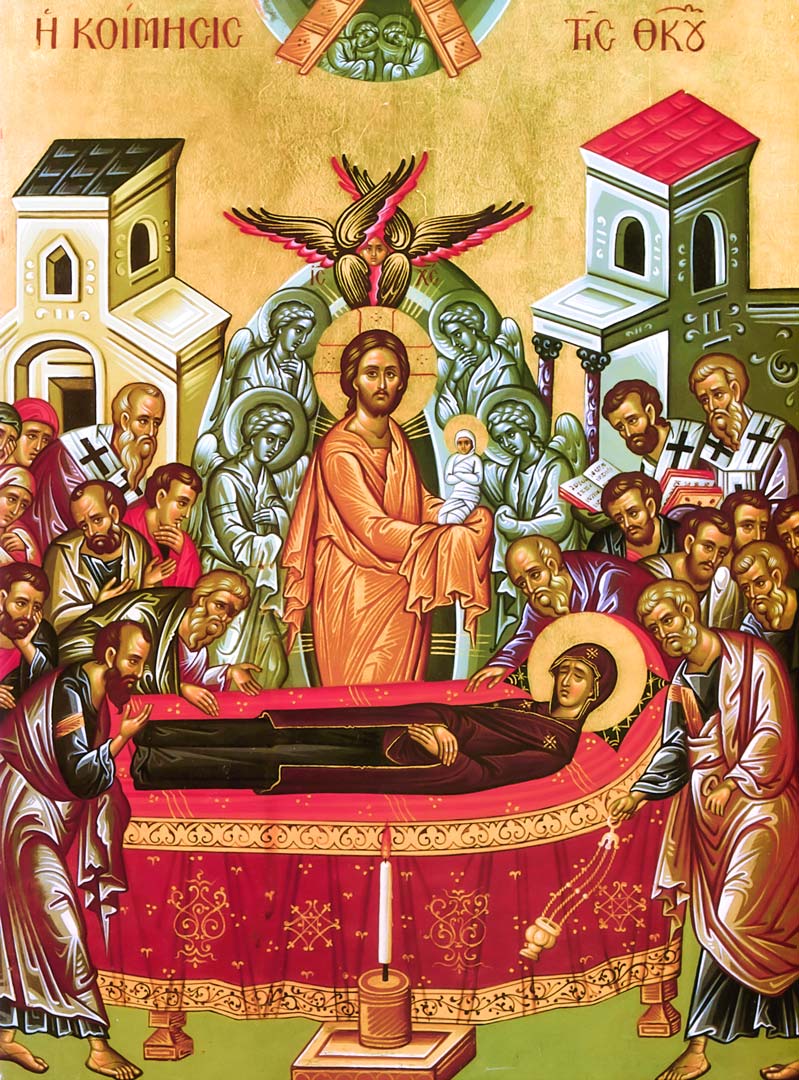 Biblical Story
Biblical Story The Holy Scriptures tell us that when our Lord was dying on the Cross, He saw His mother and His disciple John and said to the Virgin Mary, "Woman, behold your son!" and to John, "Behold your mother!" (John 19:25-27). From that hour, the Apostle took care of the Theotokos in his own home.
Along with the biblical reference in Acts 1:14 that confirms that the Virgin Mary was with the Holy Apostles on the day of Pentecost, the tradition of the Church holds that she remained in the home of the Apostle John in Jerusalem, continuing a ministry in word and deed.
At the time of her death, the disciples of our Lord who were preaching throughout the world returned to Jerusalem to see the Theotokos. Except for the Apostle Thomas, all of them including the Apostle Paul were gathered together at her bedside. At the moment of her death, Jesus Christ himself descended and carried her soul into heaven.
Following her repose, the body of the Theotokos was taken in procession and laid in a tomb near the Garden of Gethsemane. When the Apostle Thomas arrived three days after her repose and desired to see her body, the tomb was found to be empty. The bodily assumption of the Theotokos was confirmed by the message of an angel and by her appearance to the Apostles.
Icon of the Feast
The Icon of the Feast of the Dormition of the Theotokos shows her on her deathbed surrounded by the Apostles. Christ is standing in the center (1.) looking at His mother. He is holding a small child clothed in white representing the soul of the Virgin Mary. With His golden garments, the angels above His head, and the mandorla surrounding Him, Christ is depicted in His divine glory.
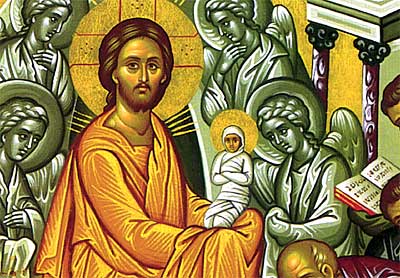
The posture of the Apostles direct attention toward the Theotokos (2.). On the right Saint Peter censes the body of the Theotokos. On the left Saint Paul (3.) bows low in honor of her.

Together with the Apostles are several bishops (4.) and women. The bishops traditionally represented are James, the brother of the Lord, Timothy, Heirotheus, and Dionysius the Areopagite. They are shown wearing episcopal vestments. The women are members of the church in Jerusalem.
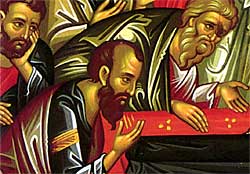
3. The Apostle Paul bows in honor of the Theotokos (detail).
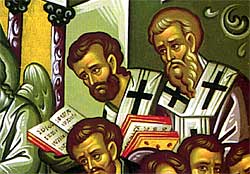
4. Also in attendance to pray for the Theotokos were several Bishops (detail).
In front of the bed of the Theotokos is a candle (5.) that helps to form a central axis in the icon. Above the candle is the body of the Theotokos and Ever-Virgin Mary. Standing over His mother is Christ holding her most pure soul. Above Christ the gates of heaven stand open, ready to receive the Mother of God.
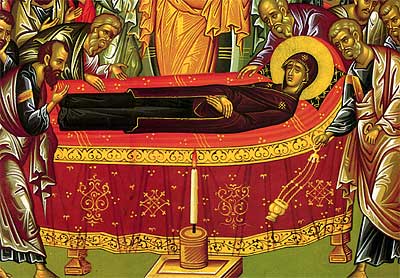
This great Feast of the Church and the icon celebrates a fundamental teaching of our faith—the Resurrection of the body. In the case of the Theotokos, this has been accomplished by the divine will of God. Thus, this Feast is a feast of hope, hope in Resurrection and life eternal. Like those who gathered around the body of the Virgin Mary, we gather around our departed loved ones and commend their souls into the hands of Christ. As we remember those who have reposed in the faith before us and have passed on into the communion of the Saints, we prepare ourselves to one day be received into the new life of the age to come.
We also affirm through this Feast as we journey toward our heavenly abode that the Mother of God intercedes for us. Through Christ she has become the mother of all of the children of God, embracing us with divine love.
Dormition or Assumption?
In the Orthodox tradition we are usually very careful to distinguish between the “Dormition” of the Mother of God and her “Assumption” into heaven. The former, we feel, is properly Orthodox, while the latter strikes us as a purely Western designation, derived from a Papist “misunderstanding” of the meaning of this feast, celebrated universally on August 15.
A misguided interpretations of Mary’s death and exaltation can be found both in Papist spiritual writings and in contemporary Western images: a tendency, for example, to exalt the Holy Virgin to a level of “divinity” that effectively erases the crucial and absolute distinction between human and divine life. Orthodox theologians will insist that the “deification” (theôsis) known by the Mother of God in no way involves an ontological transformation of her being from created humanity to divinity. She was and will always remain a human creature: the most exalted of all those who bear God’s image, yet always a human being, whose glory appears in her humility, her simple desire to “let it be” according to the divine will.
Traditional Orthodox icons of her “falling asleep,” therefore, focus especially on her death and entombment. The disciples, “gathered together from all the ends of the earth,” surround her in an attitude of grief and lament. Behind the bier on which she is laid there stands her glorified Son, holding in His arms a child clothed in radiant white garments, an image of His Mother’s soul. This is a theme of reversal. On every Orthodox iconastasis there is found a sacred image of the Mother of God, holding in her arms her newborn child, the God-Man who “took flesh” in order to save and sanctify a fallen, sinful, broken world. Here, in the icon of the Dormition, the Son embraces and offers to that world His Holy Mother, as she did Him at the time of His birth. At her falling asleep He receives her soul, her life, in order to exalt it in Himself and with Himself, to the glory, beauty and joy of eternal life.
Celebration of the Feast of the Dormition
The commemoration of the Dormition of the Theotokos and the preparation for the Feast begin on August 1 with a period of fasting. A strict fast is followed on most of the days (no meat, dairy, oil, or wine), with the exceptions of fish on the Feast of the Transfiguration (August 6) and the day of the Dormition. Oil and Wine are allowed on Saturdays and Sundays.
On the weekdays before the Feast, Paraklesis services are held in most parishes. These consist of the Great Paraklesis and the Small Paraklesis, both services of supplication and prayer for the intercessions of the Theotokos.
The Feast of the Dormition is celebrated with the Divine Liturgy of Saint John Chrysostom which is conducted on the morning of the Feast and preceded by a Matins (Orthros) service. A Great Vespers is conducted on the evening before the day of the Feast. Scripture readings for the Feast of the Dormition are the following: At Vespers: Genesis 28:10-17; Ezekiel 43:27-44:4; Proverbs 9:1-11. At the Matins: Luke 1:39-49, 56. At the Divine Liturgy: Philippians 2:5-11; Luke 10:38-42; 11:27-28.
----------------------------------------------
ESPAÑOL:
Introducción
La fiesta de la Dormición de Nuestra Santísima Señora, Theotokos y Siempre Virgen María se celebra el 15 de agosto de cada año. La fiesta conmemora el reposo (dormición y en la Koimisis griega) o "quedarse dormido" de la Madre de Jesucristo, nuestro Señor. La fiesta también conmemora la traducción o asunción al cielo del cuerpo de la Theotokos.
Historia bíblica
 Las
Sagradas Escrituras nos dicen que cuando nuestro Señor estaba muriendo
en la Cruz, vio a su madre y a su discípulo Juan y le dijo a la Virgen
María: "¡Mujer, mira a tu hijo!" y a Juan, "¡Mira a tu madre!" (Juan 19:
25-27). A partir de esa hora, el Apóstol se hizo cargo de la Theotokos
en su propia casa.
Junto con la referencia bíblica en Hechos 1:14 que confirma que la
Virgen María estaba con los Santos Apóstoles el día de Pentecostés, la
tradición de la Iglesia sostiene que permaneció en el hogar del Apóstol
Juan en Jerusalén, continuando un ministerio en palabra y obra.
En el momento de su muerte, los discípulos de nuestro Señor que
predicaban en todo el mundo regresaron a Jerusalén para ver la Theotokos. A excepción del apóstol Tomás, todos ellos, incluido el
apóstol Pablo, se reunieron junto a su cama. En el momento de su muerte,
Jesucristo mismo descendió y llevó su alma al cielo.
Después de su reposo, el cuerpo de Theotokos fue llevado en procesión y
colocado en una tumba cerca del Jardín de Getsemaní. Cuando el apóstol
Tomás llegó tres días después de su descanso y deseó ver su cuerpo, se
encontró que la tumba estaba vacía. La asunción corporal de la Theotokos
fue confirmada por el mensaje de un ángel y por su aparición a los
Apóstoles.
Las
Sagradas Escrituras nos dicen que cuando nuestro Señor estaba muriendo
en la Cruz, vio a su madre y a su discípulo Juan y le dijo a la Virgen
María: "¡Mujer, mira a tu hijo!" y a Juan, "¡Mira a tu madre!" (Juan 19:
25-27). A partir de esa hora, el Apóstol se hizo cargo de la Theotokos
en su propia casa.
Junto con la referencia bíblica en Hechos 1:14 que confirma que la
Virgen María estaba con los Santos Apóstoles el día de Pentecostés, la
tradición de la Iglesia sostiene que permaneció en el hogar del Apóstol
Juan en Jerusalén, continuando un ministerio en palabra y obra.
En el momento de su muerte, los discípulos de nuestro Señor que
predicaban en todo el mundo regresaron a Jerusalén para ver la Theotokos. A excepción del apóstol Tomás, todos ellos, incluido el
apóstol Pablo, se reunieron junto a su cama. En el momento de su muerte,
Jesucristo mismo descendió y llevó su alma al cielo.
Después de su reposo, el cuerpo de Theotokos fue llevado en procesión y
colocado en una tumba cerca del Jardín de Getsemaní. Cuando el apóstol
Tomás llegó tres días después de su descanso y deseó ver su cuerpo, se
encontró que la tumba estaba vacía. La asunción corporal de la Theotokos
fue confirmada por el mensaje de un ángel y por su aparición a los
Apóstoles.
Icono de la fiesta
El ícono de la fiesta de la Dormición de la Theotokos la muestra en su lecho de muerte rodeada de los Apóstoles. Cristo está de pie en el centro (1.) mirando a su madre. Él está sosteniendo a un niño pequeño vestido de blanco que representa el alma de la Virgen María. Con sus vestiduras doradas, los ángeles sobre su cabeza y la mandorla que lo rodea, Cristo está representado en su gloria divina.
1.
Cristo, apareciendo en Su Gloria, se encuentra en el centro del ícono
que acuna el alma de Su Madre, Theotokos y Siempre Virgen María.
La postura de los Apóstoles dirige la atención hacia el Theotokos (2.). A la derecha, San Pedro censura el cuerpo de la Theotokos. A la izquierda, San Pablo (3.) se inclina en honor de ella.

2. Los apóstoles inclinan sus cabezas en reverencia a la Theotokos cuando San Pedro (derecha) censura su cuerpo (detalle).
Junto con los apóstoles hay varios obispos (4) y mujeres. Los obispos tradicionalmente representados son Santiago, el hermano del Señor, Timoteo, Heirotheo y Dionisio el Areopagito. Se muestran con vestimentas episcopales. Las mujeres son miembros de la iglesia en Jerusalén.
3. El apóstol Pablo se inclina en honor a la Theotokos (detalle).

4. También asistieron a rezar por los Theotokos varios obispos (detalle).
Delante de la cama de la Theotokos hay una vela (5) que ayuda a formar un eje central en el ícono. Sobre la vela está el cuerpo de la Theotokos y Siempre Virgen María. De pie junto a su madre está Cristo sosteniendo su alma más pura. Sobre Cristo se abren las puertas del cielo, listas para recibir a la Madre de Dios.

Dormición de la Madre de Dios
A misguided interpretations of Mary’s death and exaltation can be found both in Papist spiritual writings and in contemporary Western images: a tendency, for example, to exalt the Holy Virgin to a level of “divinity” that effectively erases the crucial and absolute distinction between human and divine life. Orthodox theologians will insist that the “deification” (theôsis) known by the Mother of God in no way involves an ontological transformation of her being from created humanity to divinity. She was and will always remain a human creature: the most exalted of all those who bear God’s image, yet always a human being, whose glory appears in her humility, her simple desire to “let it be” according to the divine will.
Traditional Orthodox icons of her “falling asleep,” therefore, focus especially on her death and entombment. The disciples, “gathered together from all the ends of the earth,” surround her in an attitude of grief and lament. Behind the bier on which she is laid there stands her glorified Son, holding in His arms a child clothed in radiant white garments, an image of His Mother’s soul. This is a theme of reversal. On every Orthodox iconastasis there is found a sacred image of the Mother of God, holding in her arms her newborn child, the God-Man who “took flesh” in order to save and sanctify a fallen, sinful, broken world. Here, in the icon of the Dormition, the Son embraces and offers to that world His Holy Mother, as she did Him at the time of His birth. At her falling asleep He receives her soul, her life, in order to exalt it in Himself and with Himself, to the glory, beauty and joy of eternal life.
Celebration of the Feast of the Dormition
The commemoration of the Dormition of the Theotokos and the preparation for the Feast begin on August 1 with a period of fasting. A strict fast is followed on most of the days (no meat, dairy, oil, or wine), with the exceptions of fish on the Feast of the Transfiguration (August 6) and the day of the Dormition. Oil and Wine are allowed on Saturdays and Sundays.
On the weekdays before the Feast, Paraklesis services are held in most parishes. These consist of the Great Paraklesis and the Small Paraklesis, both services of supplication and prayer for the intercessions of the Theotokos.
The Feast of the Dormition is celebrated with the Divine Liturgy of Saint John Chrysostom which is conducted on the morning of the Feast and preceded by a Matins (Orthros) service. A Great Vespers is conducted on the evening before the day of the Feast. Scripture readings for the Feast of the Dormition are the following: At Vespers: Genesis 28:10-17; Ezekiel 43:27-44:4; Proverbs 9:1-11. At the Matins: Luke 1:39-49, 56. At the Divine Liturgy: Philippians 2:5-11; Luke 10:38-42; 11:27-28.
----------------------------------------------
ESPAÑOL:
Introducción
La fiesta de la Dormición de Nuestra Santísima Señora, Theotokos y Siempre Virgen María se celebra el 15 de agosto de cada año. La fiesta conmemora el reposo (dormición y en la Koimisis griega) o "quedarse dormido" de la Madre de Jesucristo, nuestro Señor. La fiesta también conmemora la traducción o asunción al cielo del cuerpo de la Theotokos.
Historia bíblica
 Las
Sagradas Escrituras nos dicen que cuando nuestro Señor estaba muriendo
en la Cruz, vio a su madre y a su discípulo Juan y le dijo a la Virgen
María: "¡Mujer, mira a tu hijo!" y a Juan, "¡Mira a tu madre!" (Juan 19:
25-27). A partir de esa hora, el Apóstol se hizo cargo de la Theotokos
en su propia casa.
Junto con la referencia bíblica en Hechos 1:14 que confirma que la
Virgen María estaba con los Santos Apóstoles el día de Pentecostés, la
tradición de la Iglesia sostiene que permaneció en el hogar del Apóstol
Juan en Jerusalén, continuando un ministerio en palabra y obra.
En el momento de su muerte, los discípulos de nuestro Señor que
predicaban en todo el mundo regresaron a Jerusalén para ver la Theotokos. A excepción del apóstol Tomás, todos ellos, incluido el
apóstol Pablo, se reunieron junto a su cama. En el momento de su muerte,
Jesucristo mismo descendió y llevó su alma al cielo.
Después de su reposo, el cuerpo de Theotokos fue llevado en procesión y
colocado en una tumba cerca del Jardín de Getsemaní. Cuando el apóstol
Tomás llegó tres días después de su descanso y deseó ver su cuerpo, se
encontró que la tumba estaba vacía. La asunción corporal de la Theotokos
fue confirmada por el mensaje de un ángel y por su aparición a los
Apóstoles.
Las
Sagradas Escrituras nos dicen que cuando nuestro Señor estaba muriendo
en la Cruz, vio a su madre y a su discípulo Juan y le dijo a la Virgen
María: "¡Mujer, mira a tu hijo!" y a Juan, "¡Mira a tu madre!" (Juan 19:
25-27). A partir de esa hora, el Apóstol se hizo cargo de la Theotokos
en su propia casa.
Junto con la referencia bíblica en Hechos 1:14 que confirma que la
Virgen María estaba con los Santos Apóstoles el día de Pentecostés, la
tradición de la Iglesia sostiene que permaneció en el hogar del Apóstol
Juan en Jerusalén, continuando un ministerio en palabra y obra.
En el momento de su muerte, los discípulos de nuestro Señor que
predicaban en todo el mundo regresaron a Jerusalén para ver la Theotokos. A excepción del apóstol Tomás, todos ellos, incluido el
apóstol Pablo, se reunieron junto a su cama. En el momento de su muerte,
Jesucristo mismo descendió y llevó su alma al cielo.
Después de su reposo, el cuerpo de Theotokos fue llevado en procesión y
colocado en una tumba cerca del Jardín de Getsemaní. Cuando el apóstol
Tomás llegó tres días después de su descanso y deseó ver su cuerpo, se
encontró que la tumba estaba vacía. La asunción corporal de la Theotokos
fue confirmada por el mensaje de un ángel y por su aparición a los
Apóstoles.Icono de la fiesta
El ícono de la fiesta de la Dormición de la Theotokos la muestra en su lecho de muerte rodeada de los Apóstoles. Cristo está de pie en el centro (1.) mirando a su madre. Él está sosteniendo a un niño pequeño vestido de blanco que representa el alma de la Virgen María. Con sus vestiduras doradas, los ángeles sobre su cabeza y la mandorla que lo rodea, Cristo está representado en su gloria divina.
La postura de los Apóstoles dirige la atención hacia el Theotokos (2.). A la derecha, San Pedro censura el cuerpo de la Theotokos. A la izquierda, San Pablo (3.) se inclina en honor de ella.

2. Los apóstoles inclinan sus cabezas en reverencia a la Theotokos cuando San Pedro (derecha) censura su cuerpo (detalle).
Junto con los apóstoles hay varios obispos (4) y mujeres. Los obispos tradicionalmente representados son Santiago, el hermano del Señor, Timoteo, Heirotheo y Dionisio el Areopagito. Se muestran con vestimentas episcopales. Las mujeres son miembros de la iglesia en Jerusalén.
3. El apóstol Pablo se inclina en honor a la Theotokos (detalle).

4. También asistieron a rezar por los Theotokos varios obispos (detalle).
Delante de la cama de la Theotokos hay una vela (5) que ayuda a formar un eje central en el ícono. Sobre la vela está el cuerpo de la Theotokos y Siempre Virgen María. De pie junto a su madre está Cristo sosteniendo su alma más pura. Sobre Cristo se abren las puertas del cielo, listas para recibir a la Madre de Dios.

5. Theotokos se encuentra en el centro del icono rodeado por los Apóstoles y una vela frente a su cama (detalle).
Esta
gran fiesta de la Iglesia y el ícono celebra una enseñanza fundamental
de nuestra fe: la resurrección del cuerpo. En el caso de la Theotokos, esto
se ha logrado por la voluntad divina de Dios. Así, esta fiesta es una
fiesta de esperanza, esperanza en la resurrección y vida eterna. Al
igual que aquellos que se reunieron alrededor del cuerpo de la Virgen
María, nos reunimos alrededor de nuestros seres queridos difuntos y
encomendamos sus almas a las manos de Cristo. Al recordar a aquellos que
se han vuelto a depositar en la fe antes que nosotros y han pasado a la
comunión de los santos, nos preparamos para ser recibidos algún día en
la nueva vida del siglo venidero.
También
afirmamos a través de esta Fiesta mientras viajamos hacia nuestra
morada celestial que la Madre de Dios intercede por nosotros. Por medio
de Cristo, ella se convirtió en la madre de todos los hijos de Dios,
abrazándonos con amor divino.
¿Dormición o Asunción?
En la tradición ortodoxa solemos tener mucho cuidado de distinguir entre la "Dormición" de la Madre de Dios y su "Asunción" al cielo. Creemos que el primero es propiamente ortodoxo, mientras que el segundo nos parece una designación puramente occidental, derivada de un “malentendido” papista del significado de esta fiesta, celebrada universalmente el 15 de agosto.
Se pueden encontrar interpretaciones equivocadas de la muerte y exaltación de María tanto en los escritos espirituales papistas como en las imágenes occidentales contemporáneas: una tendencia, por ejemplo, a exaltar a la Santísima Virgen a un nivel de "divinidad" que borra efectivamente la distinción crucial y absoluta entre los seres humanos y vida divina. Los teólogos ortodoxos insistirán en que la “deificación” (Teosis) conocida por la Madre de Dios no implica en modo alguno una transformación ontológica de su ser de humanidad creada a divinidad. Ella fue y será siempre una criatura humana: la más exaltada de todos los que llevan la imagen de Dios, pero siempre un ser humano, cuya gloria se manifiesta en su humildad, su simple deseo de “dejarlo ser” según la voluntad divina.
Los íconos ortodoxos tradicionales de su "quedarse dormida", por lo tanto, se enfocan especialmente en su muerte y sepultura. Los discípulos, “reunidos desde todos los confines de la tierra”, la rodean en actitud de dolor y lamento. Detrás del féretro sobre el que está acostada está su Hijo glorificado, sosteniendo en Sus brazos a un niño vestido con ropas blancas radiantes, una imagen del alma de Su Madre. Este es un tema de reversión. En cada iconastasis ortodoxa se encuentra una imagen sagrada de la Madre de Dios, sosteniendo en sus brazos a su hijo recién nacido, el Dios-Hombre que “se encarnó” para salvar y santificar un mundo caído, pecador y quebrantado. Aquí, en el icono de la Dormición, el Hijo abraza y ofrece a ese mundo a su Santa Madre, como lo hizo a Él en el momento de su nacimiento. Cuando ella se duerme, Él recibe su alma, su vida, para exaltarla en Sí mismo y consigo mismo, para la gloria, la belleza y el gozo de la vida eterna.
Celebración de la fiesta de la Dormición.
La
conmemoración de la Dormición de la Theotokos y la preparación para la
Fiesta comienzan el 1 de agosto con un período de ayuno. Se sigue un
ayuno estricto la mayoría de los días (sin carne, lácteos, aceite o
vino), con la excepción de los pescados en la Fiesta de la
Transfiguración (6 de agosto) y el día de la Dormición. Se permiten
aceites y vinos los sábados y domingos.
Los
días laborables antes de la Fiesta, los servicios de Paraklesis se
llevan a cabo en la mayoría de las parroquias. Estos consisten en la
Gran Paraklesis y la Pequeña Paraklesis, ambos servicios de súplica y
oración por las intercesiones de la Theotokos.
La
Fiesta de la Dormición se celebra con la Divina Liturgia de San Juan
Crisóstomo, que se lleva a cabo en la mañana de la Fiesta y precedida
por un servicio de Matins (Orthros). A Grandes Vísperas se lleva a cabo
la noche antes del día de la Fiesta. Las lecturas de las Escrituras para
la Fiesta de la Dormición son las siguientes: En las vísperas: Génesis
28: 10-17; Ezequiel 43: 27-44: 4; Proverbios 9: 1-11. En los maitines:
Lucas 1: 39-49, 56. En la Divina Liturgia: Filipenses 2: 5-11; Lucas 10:
38-42; 11: 27-28.
Dormición de la Madre de Dios






No hay comentarios:
Publicar un comentario
Nota: solo los miembros de este blog pueden publicar comentarios.